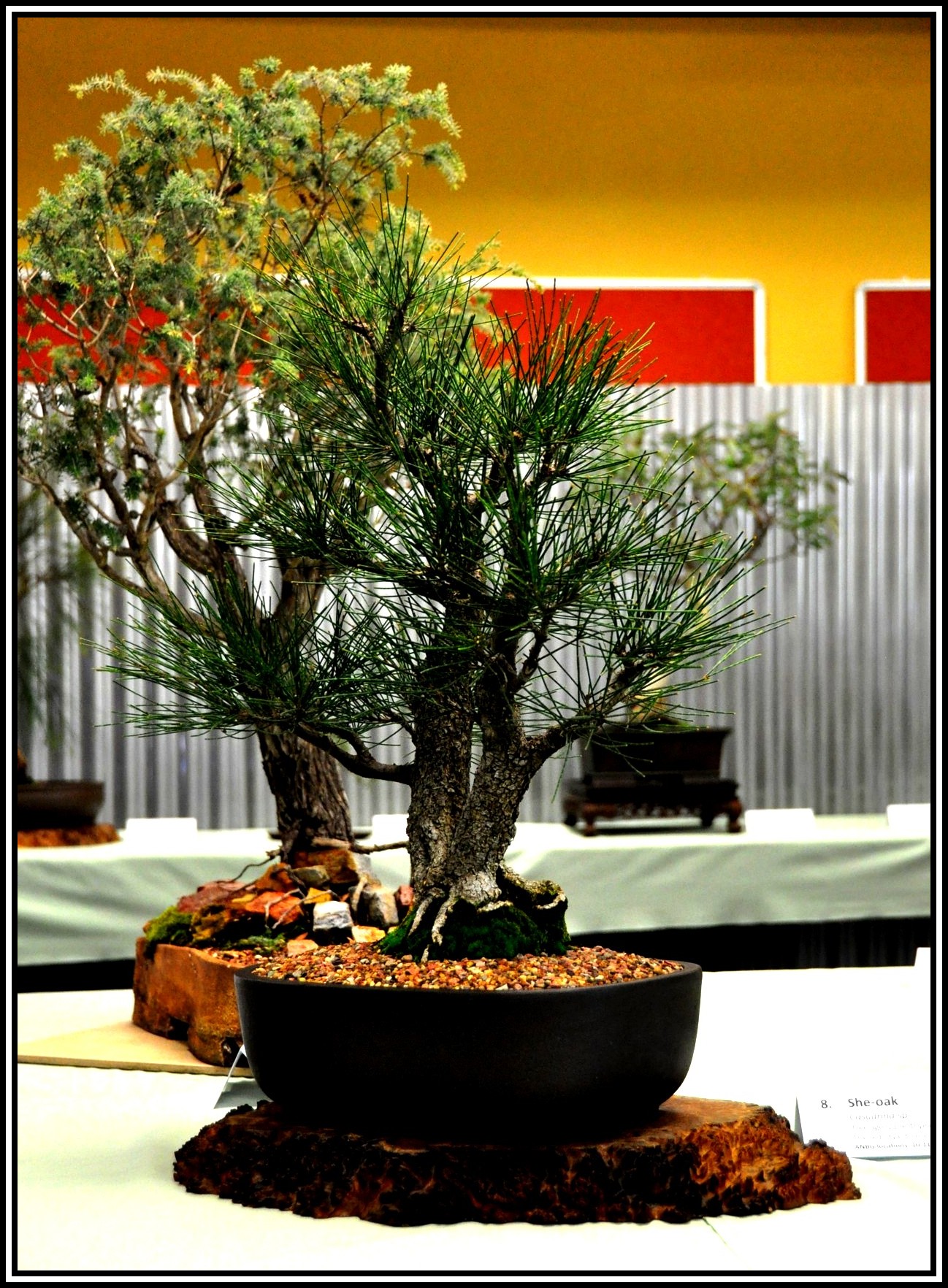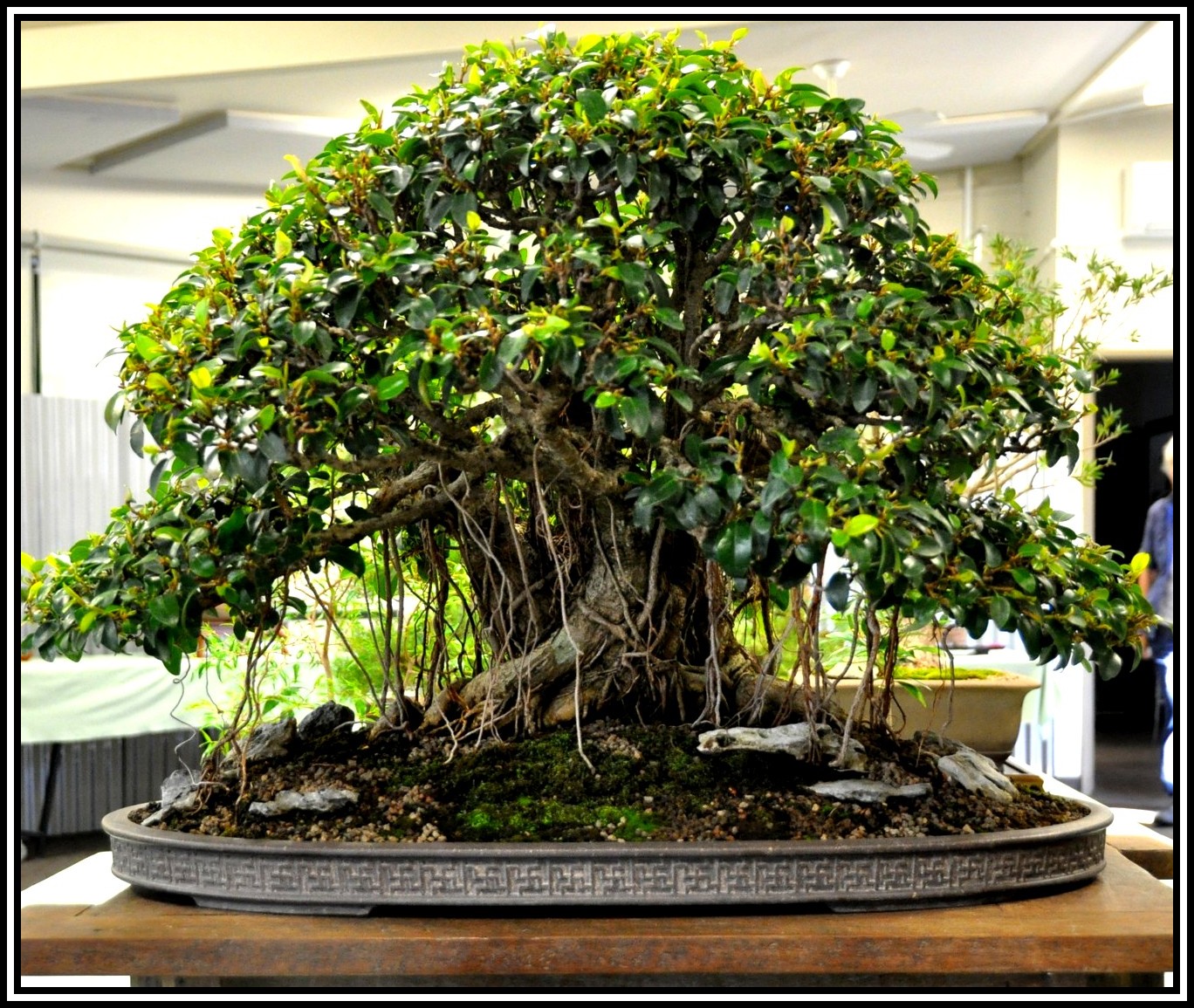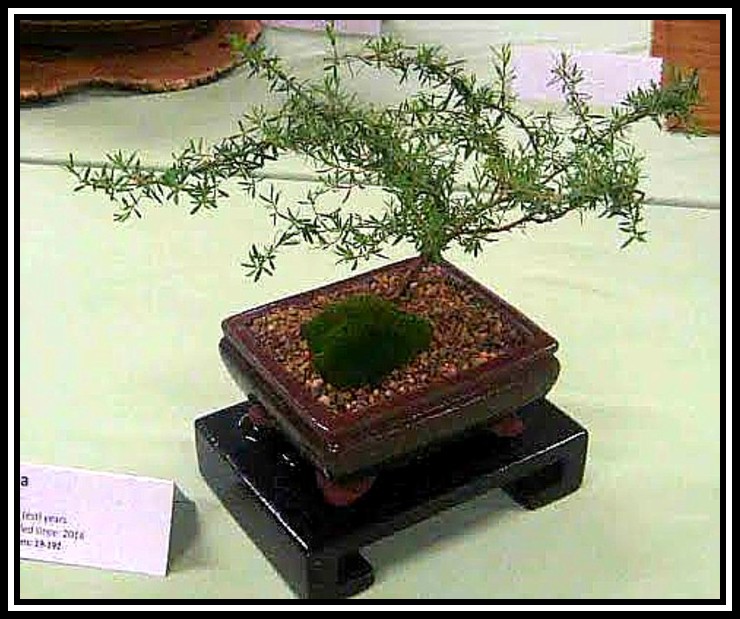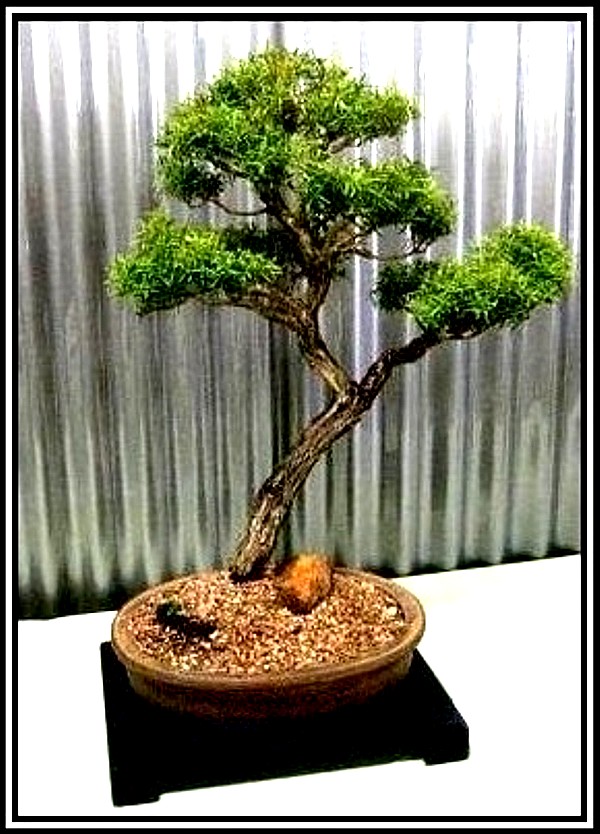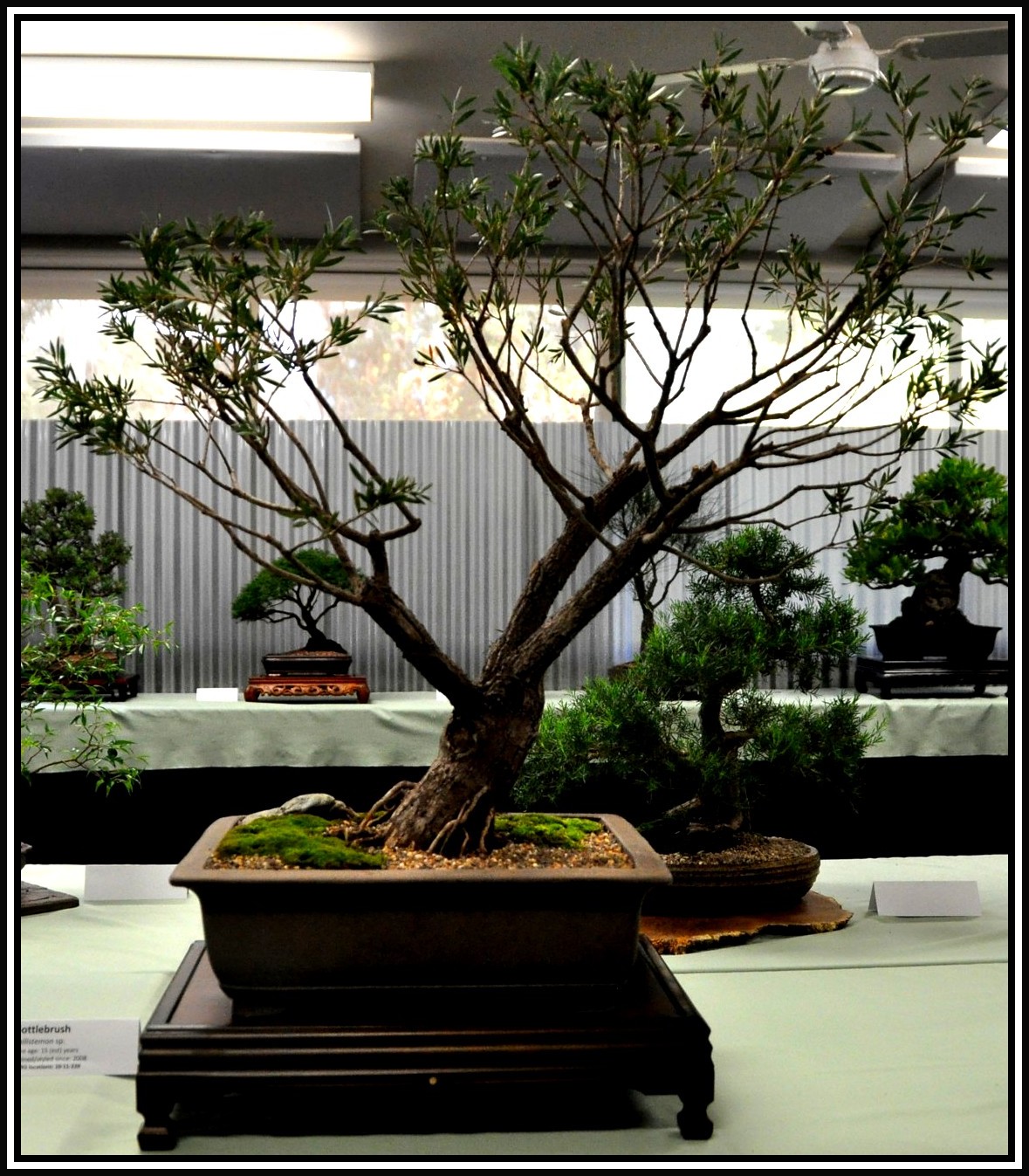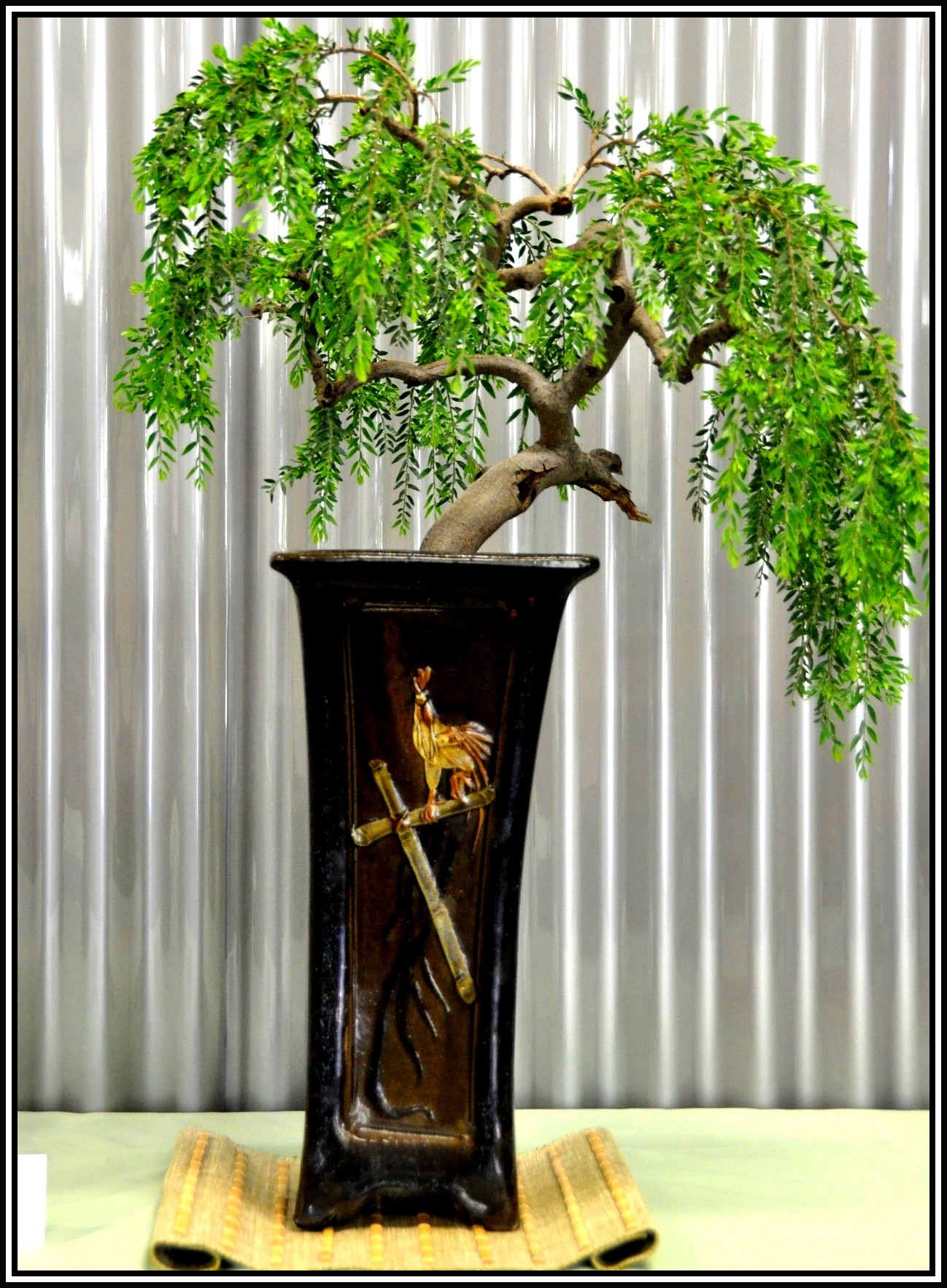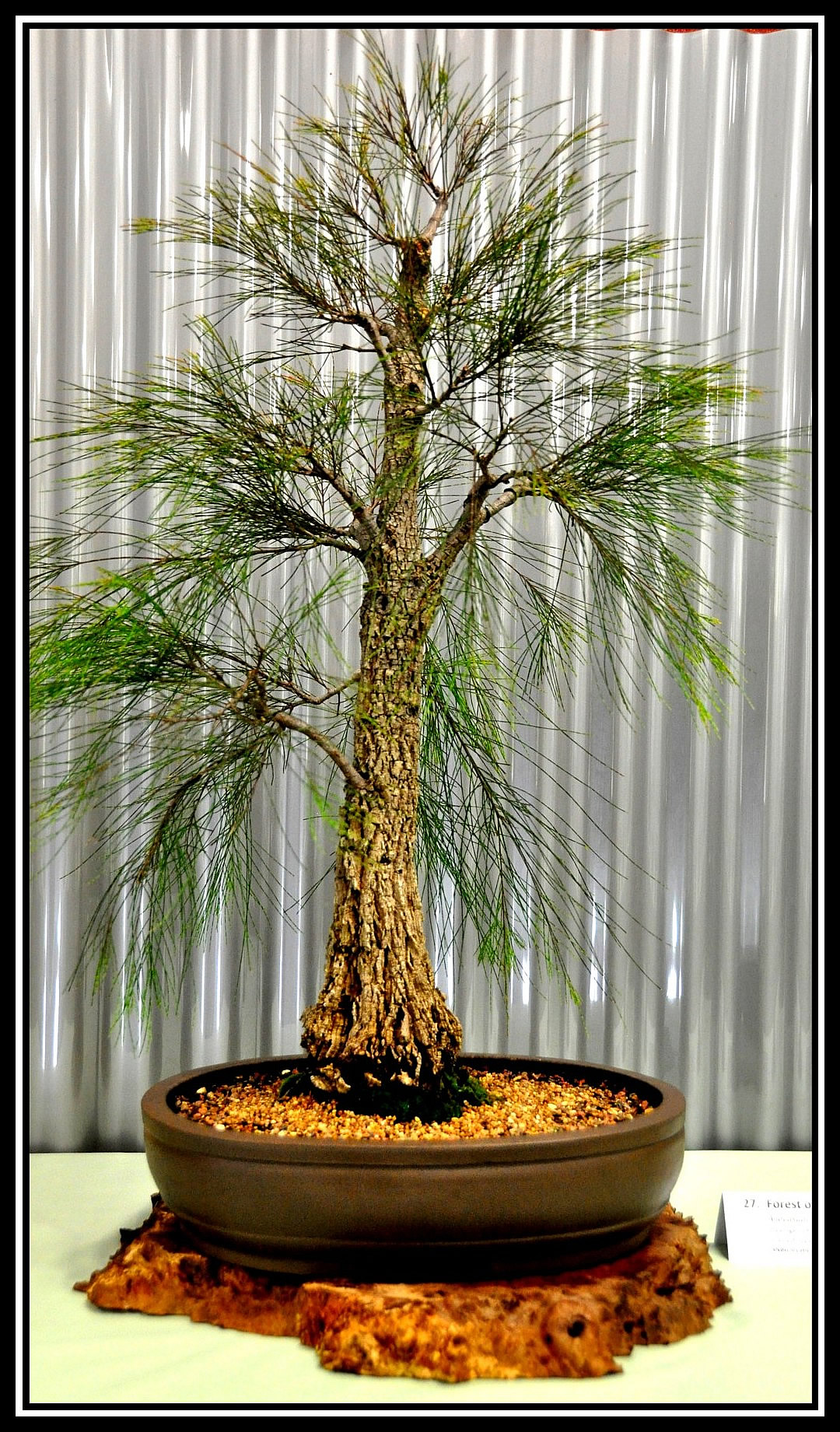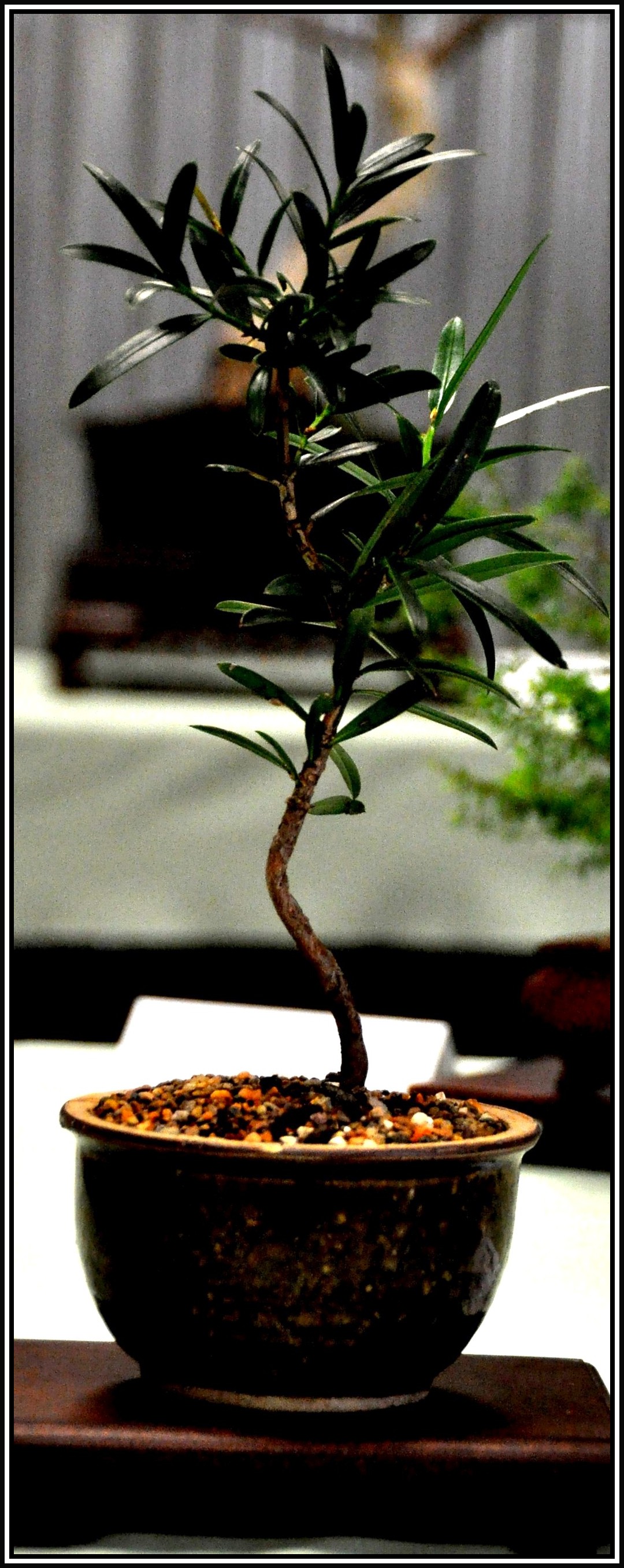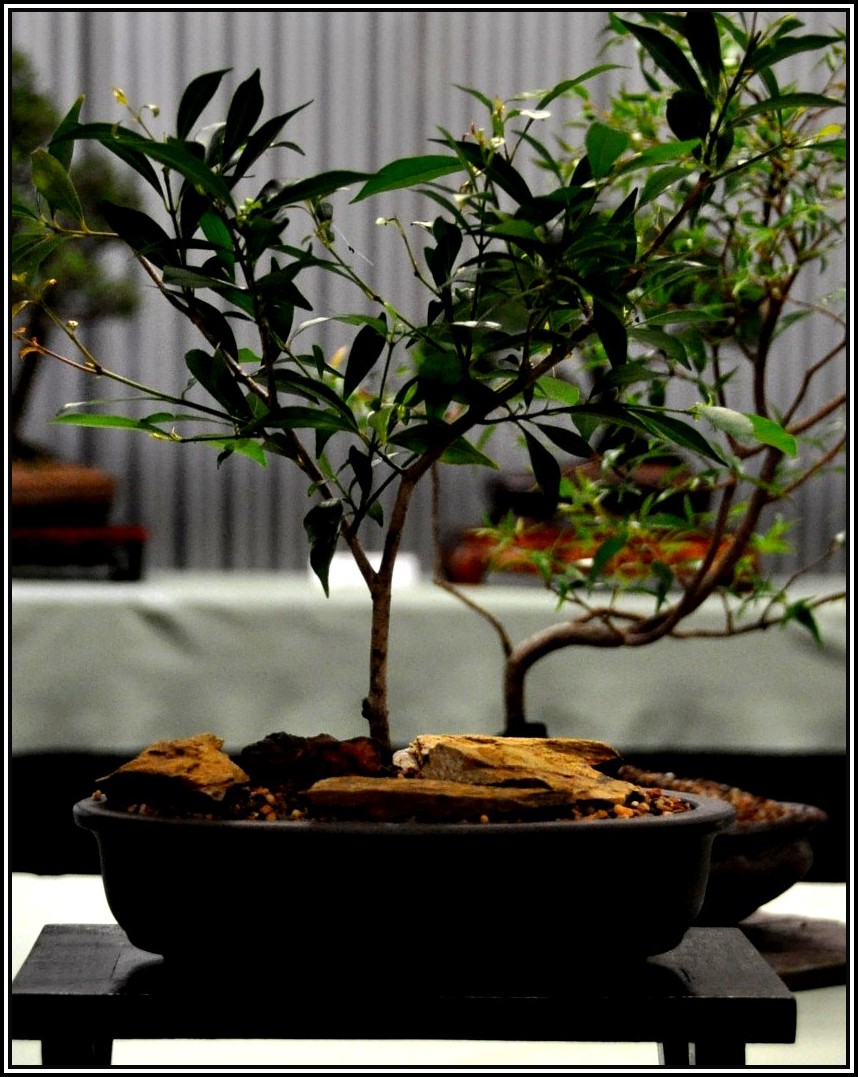Australian Native Plants as Bonsai
Catalogue Notes and Photographs from the Canberra Bonsai Society's
March 2015
Australian Plants as Bonsai Exhibition
held at the Australian National Botanic Gardens, Canberra
P
Photos by CBS members : John L, Graeme B, Barry N, Greg W
A printed map of the locations of the plants at the Australian National Botanic Gardens - as per the numbers listed
in the text below for each plant - can be obtained from the Visitor Centre at the Gardens.
Plant Species in this Exhibition |
1. Kunzea ericoides
Burgan
Age of Tree : 35 years
Trained/styled since 1985
The tree was collected 30 years ago from the Murrumbidgee River where it had been washed and broken by the regular river floods. It has lovely deadwood and age.
ANBG locations: 1‐12‐124‐31
| 
|
2. Acacia aneura
Mulga in 3 stages of development
Age of Tree : 4 + 2 years Trained/styled since 2010
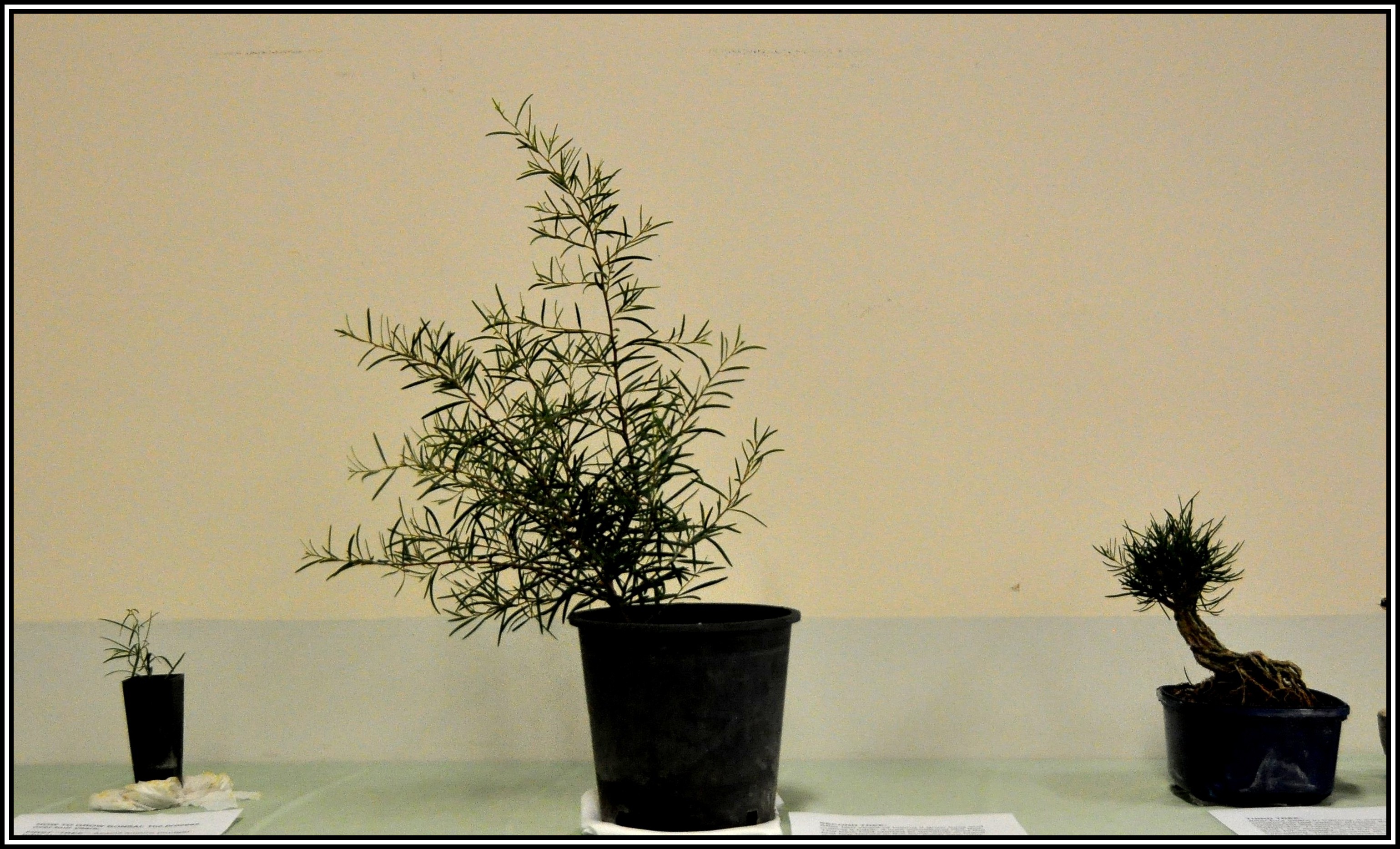
Seedling At 2 years of age At 4 years of age
Click here for details of each of these stages
ANBG locations: 99f‐210‐211‐242
|
3. Sannantha pluriflora
Tall Baekea
Age of Tree : 9 years
Trained/styled since 2009
The apeal of its multiple trunks prompted the purchase of this tree as a young plant in 2009. Some of the lower, shaded foliage died back; this accentuated the trunks and the upper foliage was developed to form the crown of the tree.
ANBG locations: 12-30-107- 143
| |
4. Casuarina cunninghamiana
River She-oak
Age of Tree : 5 years
Trained/styled since 2012
"Down by the River". Surplus one‐year old seedlings were placed in clumps in a bonsai pot and left to grow. After a year or so the trees were trimmed to create a forest outline and some internal growth was thinned.
ANBG locations: 99f-142-137
|
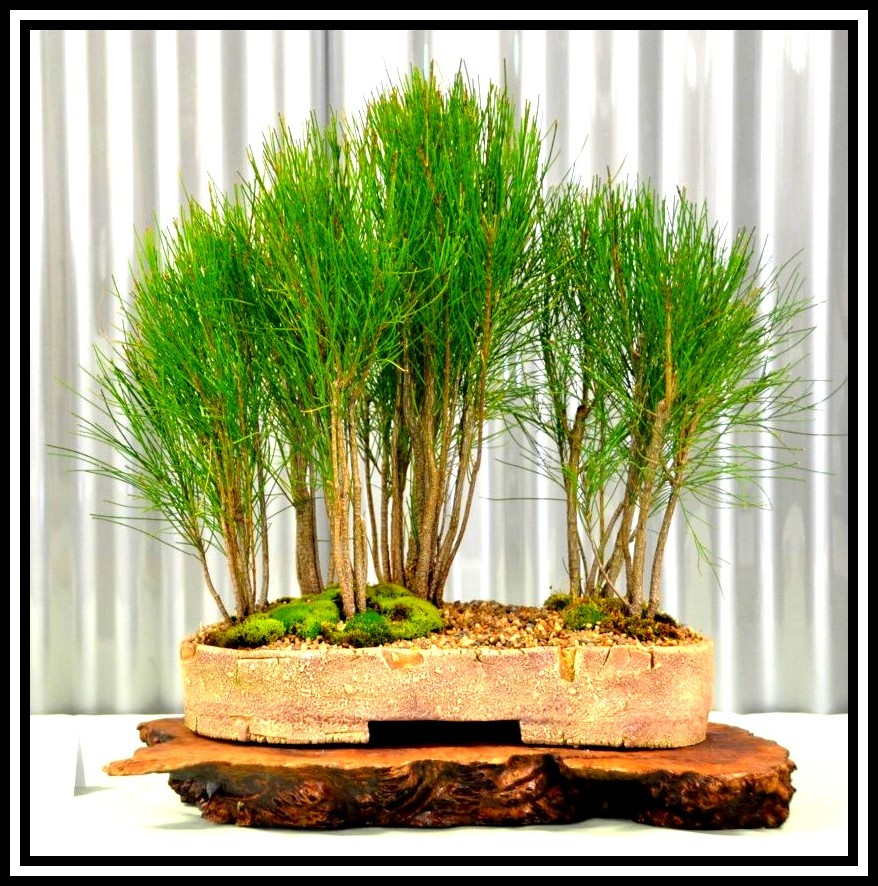 |
5. Allocasuarina torulosa
Forest Oak
Age of Tree : 17 years
Trained/styled since 2010
Inspired by a tree near Copins Crossing (since burnt in the 2003 bush fires) I wanted to create a Casuarina bonsai with an interesting trunk. Bought as tube stock, this tree has been allowed to grow pretty freely subject to occasional cutting back, with more focus in recent years on developing the branches. I like the all‐year‐round deep burgundy colour of the foliage.
ANBG locations: 141-142-170
|
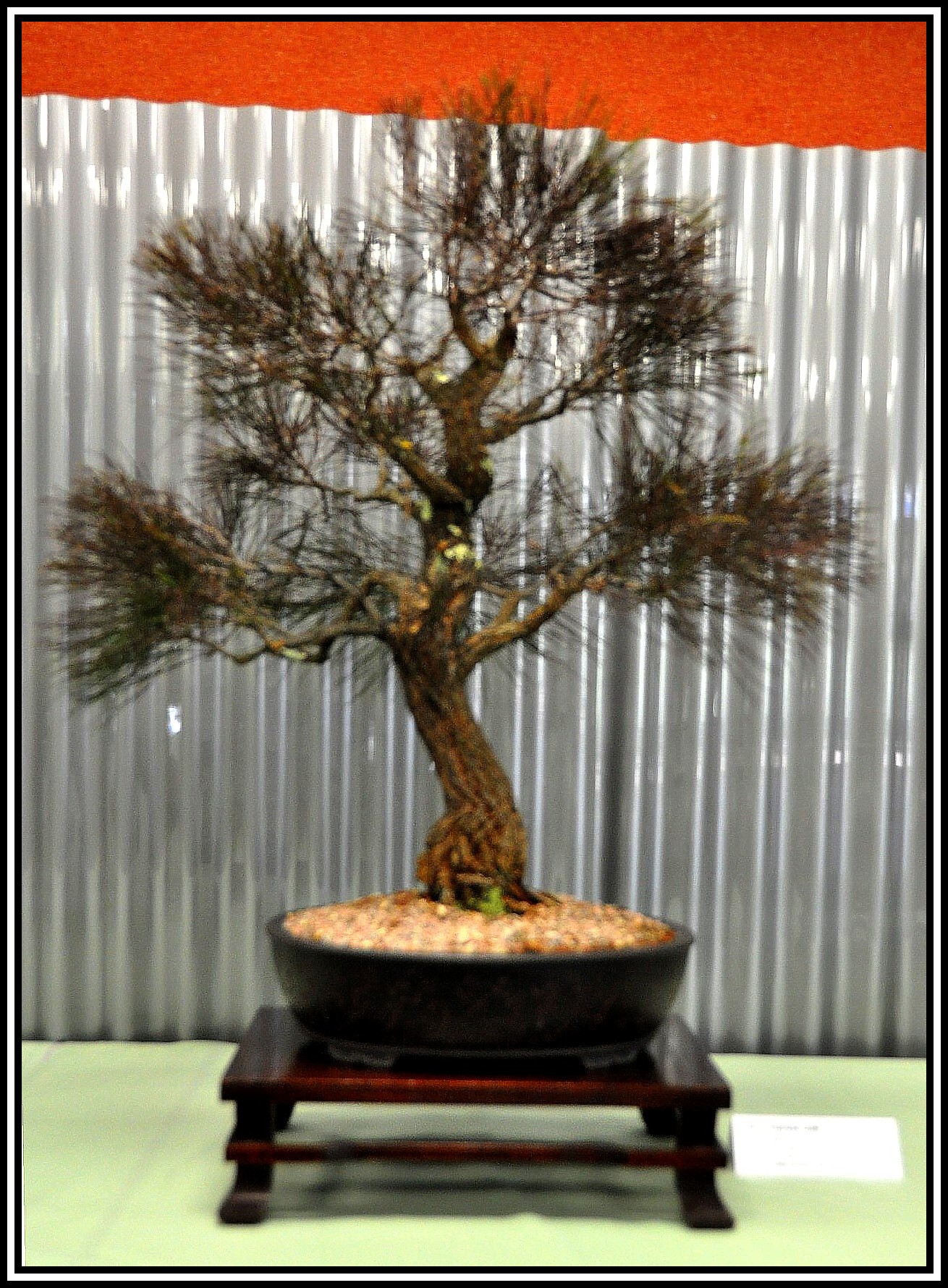 |
6. Acmena sv
Lilly Pilly
Age of Tree : 5 years (est)
Trained/styled since 2013 (est)
This was a CBS raffle prize won in 2014. It already had some movement in the branches and it had been initially root pruned. Since then, most of the material on the right of the tree has been removed to create a "windblown" image. It has frequent growth spurts, with lipstick‐pink new growth. The trunk and primary branches are very thin and while it will be returned to a larger pot after the exhibition to fatten up, I rather like the lightness and delicacy of the structure at the moment.
ANBG locations : 10-114-131
| |
7. Grevillea australis
Southern Grevillea
Age of Tree : 5 years
Trained/styled since 2012
The species grows in New South Wales, Victoria and Tasmania, generally at higher altitudes in heath and sub‐alpine woodlands. It’s the only Grevillea to occur naturally in Tasmania. In spring, it has delicate, white, spider fowers.
This bonsai started as a standard garden plant, and was initially styled at a workshop with Carol Waller in 2012. The "main" branches sat above each other like a spiral staircase ‐ not attractive! They were moved to their current, more apealling configuration by wiring. The branches are quite brittle and there have been many "accidental prunings" (aka snaped branches) along the way. New growth rapidly becomes long and straggly, requiring constant pruning. As a result it is, and probably will always be, a fairly sparse bonsai, but enjoy the delicacy of the branching and foliage.
ANBG locations: 24‐9‐31
| 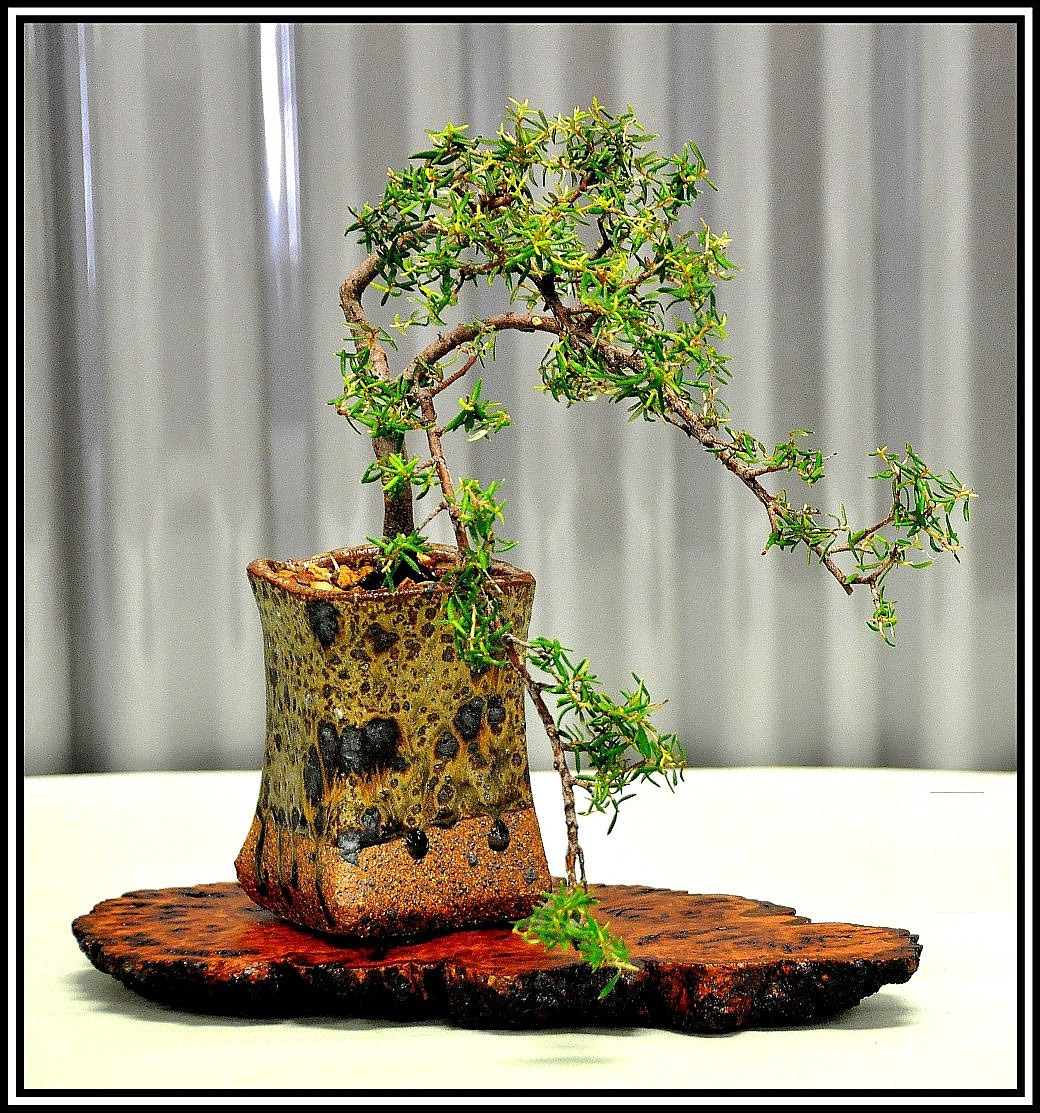
|
8. Casuarina sp.
She-Oak
Age of Tree : 21 years (est)
Trained/styled since 1999
The tree was grown from seed (1994 est), then planted into the ground (1996 est). The tree was dug up and planted into a training pot in 1999 and into a bonsai pot in 2000.
ANBG locations: 10-11-239
| |
10. Brachychiton bidwillii
Little Kurrajong
Age of Tree : 4 years
Trained/styled since 2013
Raised from seed planted in 2010, it developed the swollen trunk very quickly The leaves were very large but defoliation has reduced them somewhat. I have had to use some wire as the branches seem to make growth spurts quickly. I need to increase the branching. It produced a red flower once last year.
ANBG locations: 64‐140‐20
| 
|
11. Ficus eugenioides.
Queensland Small Leaf Fig
Age of Tree : 27 years
Trained/styled since 1991
This tree was purchased as a small stump that was ground grown nursery stock. This tree has won the BCI award for excellence and Qld State and Sunshine Coast local awards.
ANBG locations: none
| |
12. Callistemon cv
Bottlebrush
Age of Tree : 28 years
Trained/styled since 2004
This tree is urban "yamadori" in origin – having been recovered from Belconnen Mall from old landscaping being turfed out. It survived the rugged transplant well. It was first styled by Walter Pall in 2004 at AABC Conference in Canberra. It is slowly developing secondary and tertiary ramification. It is in need of some serious carving to be rid of "cut ends" look. There is always more work to do.
The shape is reminiscent of "water‐swept" form of Neil Padbury; main trunks all leaning to one side, while younger regrowth is upright. The many features of root, trunk and stems are coming together into a cohesive story about rich growth after powerful flooding storm.
ANBG locations: 10-11-239
| |
13. Melaleuca incana
Grey Honey-myrtle
Age of Tree : 11 years
Trained/styled since 2005
Grey honey‐myrtle was an old favourite of early‐mid Canberra's garden city plantings. This tree comes from seed collected from such a planting. It was planted into the ground after its frst year. Periodically the roots and branches were cut. Eventually it was transplanted into a plastic box and then a bonsai pot. The long white hairs on the leaves give the tree a bright halo in bright sun. Spring brings forth tiny scented brushes of pale yellow with minute reddish petals. A treat well worth waiting for.
The tree tells me a story of life at the top of a low rocky outcrop where erosion eats away at the soil and rocks, exposing roots as it does so. But the tree continues to grow strongly, quietly at home in this place.
ANBG locations: 11-12-170
|
|
14. Sannantha pluriflora
Tall Baekea
Age of Tree : 5 years (est)
Trained/styled since 2013
This tree was originally purchased in 2011 from a local native plant nursery in the ACT as tube stock. The tree has been worked on for the past two years to maintain its natural spreading foliage and open canopy.
ANBG locations: not known
|
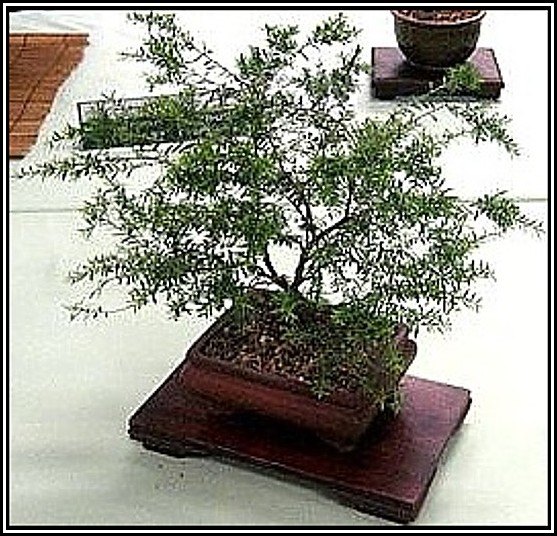 |
15. Kunzea sp
Kunzea
Age of Tree : 4 years (est)
Trained/styled since 2014
The tree was purchased from a local native plant nursery in the ACT. I was attracted to the tree because of its existing windswept style, which had been created as the tree struggled to grow in a tray of pots. It's shape immediately suggested exposure to prevailing coastal winds The slanting trunk and the branches on the leeward side of the tree were an ideal combination of features to begin development as a bonsai.
ANBG locations: not known
| |
17. Banksia marginata
Silver Banksia
Age of Tree : 13 years
Trained/styled since 2006
Banksia marginata is native to south‐eastern Australia and is the most frost hardy banksia. Purchased as small nursery stock, this tree was grown in the ground for several years with occasional cutting back. Its surface roots have developed well, adding to the feeling of a large old tree.
ANBG locations: 28-67-112
| |
18. Grevillea lanigera
Grevillea "Honeyeater Heaven"
Age of Tree : 8 years
Trained/styled since 2012
The generous display of red and cream flowers makes this tree a delight during the flowering season which may extend from autumn to spring.
ANBG locations: 107-174-223
|
 |
19. Grevillea cv
Grevillea "Poorinda Marian"
Age of Tree : 7 years
Trained/styled since 2011
Grevillea "Poorinda Marian" has a magnificent display of red flowers over spring and summer. The curving trunk and bright green foliage of this tree make it an enjoyable tree even when not flowering
ANBG location : 27
|
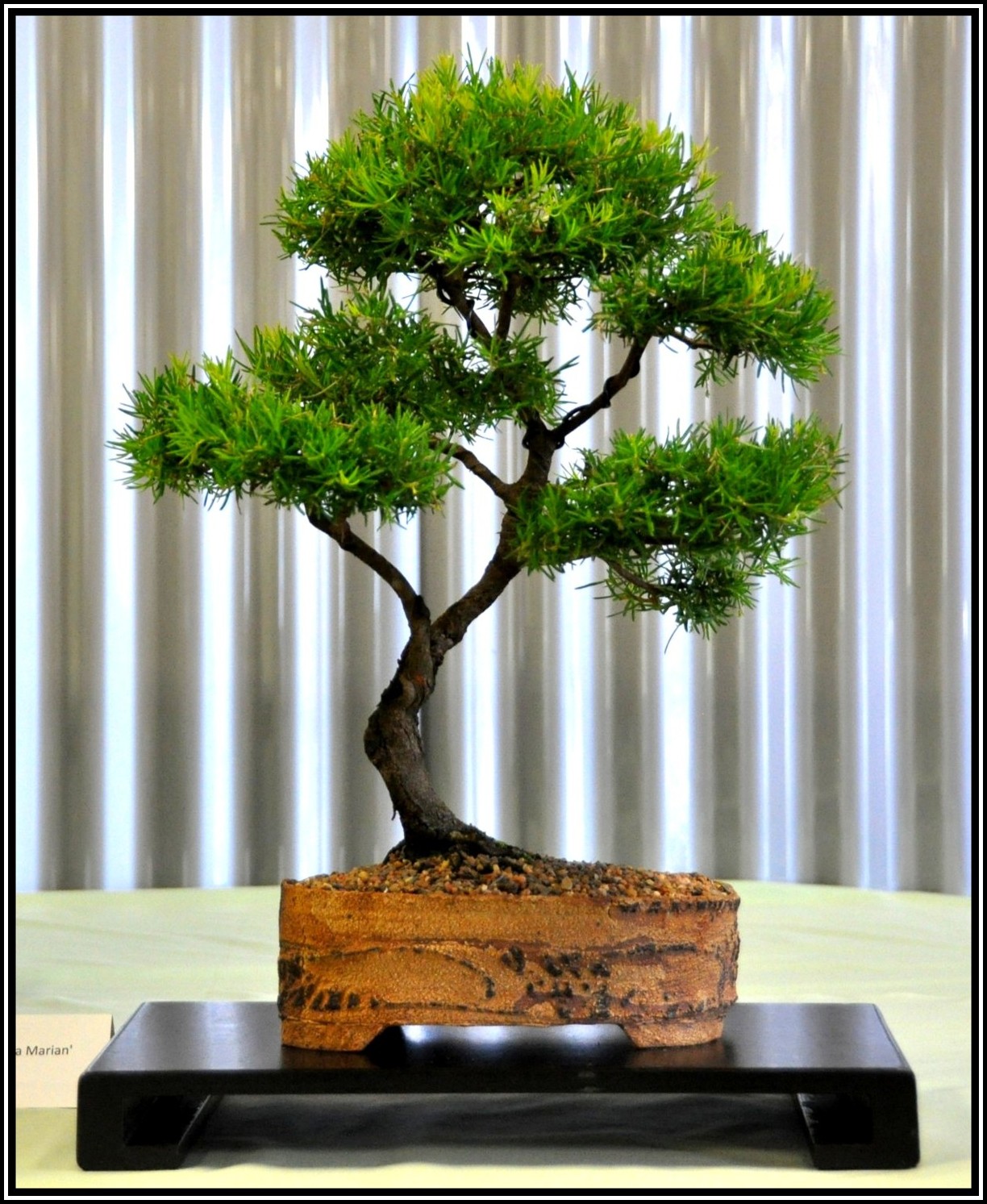 |
20. Leptospermum nitidum
Tea Tree "Copper Sheen"
Age of Tree : 16 years
Trained/styled since 2009
The cultivar name comes from the vibrant copper-red new growth that covers this tree in spring. The shape of the tree is intended to convey the sense of a lonely survivor in a harsh environment.
ANBG locations : 33-99-195
| |
21. Grevillea juniperina
Grevillea "Pink Lady"
Age of Tree : 13 years
Trained/styled since 2004
Purchased as small nursery stock, I liked the curve of the lower trunk and thought it could make a pleasant bonsai. I enjoy its soft pink flowers which used to appear from November through summer, but now seem to appear for much of the year.
ANBG locations : 24-99f-143-222
| |
22. Callitris glaucophylla
White Cypress Pine
Age of Tree : 17 years
Trained/styled since 2007
This tree was dug as a seedling from a paddock near Wagga. It was allowed to grow and thicken for a number of years before being used as a demonstration tree.
It has been restyled recently after the tree started asserting its natural habit of weeping branches and foliage. Its best characteristics are its beautiful bark and light blue colour.
It can be difficult to bend as it gets older but it does continue to bud back a little if kept pruned.
ANBG locations : none
|
 |
23. Banksia serrata
Old Man Banksia
Age of Tree : Unknown
Trained/styled since Unknown
Banksia serrata is possibly the most iconic of all Australian natives used as bonsai, despite its large leaves and huge flowers. The leaves do reduce a little in pot culture but the rugged appearance and bark are its best features. It can be made into a small bonsai but here it is a very large bonsai.
ANBG locations : 25-28-107-110
|
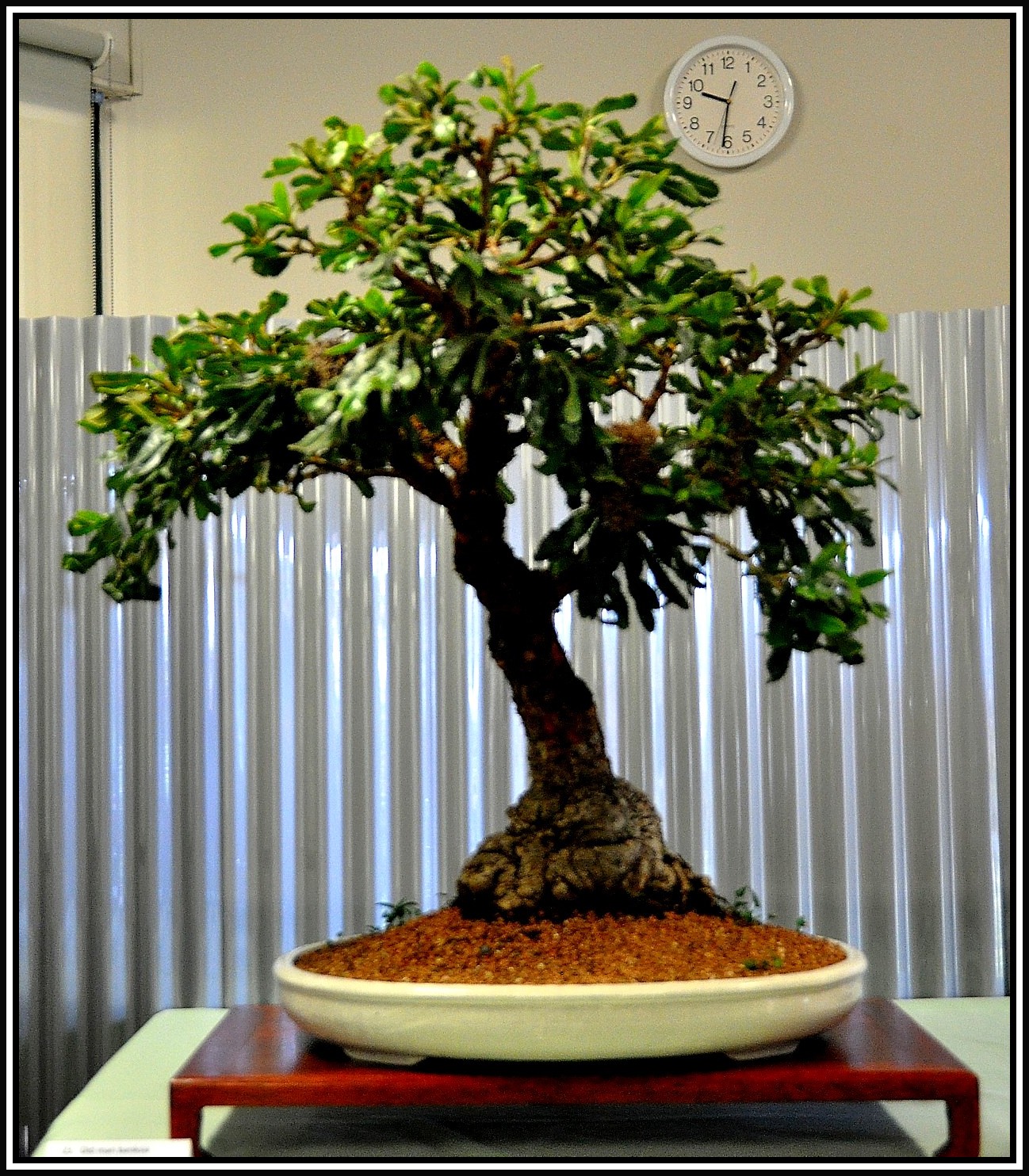 |
24. Ficus Rubiginosa
Port Jackson Fig
Age of Tree : 33 years
Trained/styled since 1995
This tree was a cutting that was ignored for many years in the back of a shade house. It was styled and put into increasing sized bonsai pots as it developed. It was defoliated in spring and produced two possible new brances as well as small leaves.
I am undecided as to whether to keep all the branches, as one small branch at the front is weak and may need to be replaced by wiring the new ones into place. Despite being quite old, the tree is very much under development.
As Port Jackson figs are frost tender, this one spends its winters in a sunny window inside.
ANBG locations : 64-145-216-219:
| |
25. Callistemon sp
Bottlebrush
Age of Tree : 15 years (est)
Trained/styled since 2008
This tree is one of several callistemons that were recovered from a planter box at the Westfield Belconnen Mall during renovations in 2002. These rescued trees were saved for possible use at the 2004 AABC Convention hosted by CBS. One was used and the others were kept by three CBS members. I gave this particular specimen to a friend who worked on it for a number of years before subsequently giving it back to me. The tree has small leaves and small (about 2cm) cream flowers. It is hardy and will hopefully develop into a better bonsai one day.
ANBG locations : 10-11-239:
| |
26. Acacia howittii
Sticky Wattle
Age of Tree : 14 years
Trained/styled since 2006
I bought this tree at a native plant nursery after seeing other examples of its use in bonsai. It spent much of its life in an "octopus" style until recently when I bit the bullet and removed several large branches to reveal a simpler, more tree-like structure.
Apart from the elegant nature of its branches and foliage, the tree rewards me in early spring with small, pale yellow flowers along its pendulous strands of foliage.
ANBG locations : 87-107-127
| |
27 Forest Oak
Allocasuarina torulosa
Age of Tree : 13 years
Trained/styled since 2006
This tree began its journey as a nursery plant in a black plastic pot. I was inpired to develop a bonsai with this species, in part because of the tranquil experience that one gains when standing in a group of casuarinas (a close relative) such as those accessible to the public along the Murrumbidgee river, and because I had seen (and enjoyed) other bonsai like this which meant that I had a fair chance of success
ANBG locations: 141 ‐142‐170
| |
28. Callistemon sp
Bottlebrush
Age of Tree : unknown
Trained/styled since 2004
This tree was dug from my front yard after moving in 2003. It is only one of three that survived. When in flower it is spectacular.
ANBG locations : 10-11-239
|
 |
29. Banksia serrata
Saw Banksia
Age of Tree : unknown
Trained/styled since 2003
This tree was bought from a bonsai nursery man who had collected the raw material from the bush. I have refined it since buying it in 2003 and it has never flowered.
ANBG locations : 25-28-107-110
| |
30. Eucalyptus mannifera
Brittle Gum
Age of Tree : unknown
Trained/styled since 2000
This tree was bought as a stock plant from a local nursery in 2000. Originally labelled incorrectly, it took a few years to identify the variety.
Like all varieties of eucalypts I work with, it is a challenge to understand the horticulture to enable survival in pot culture. The inspiration for the design is all around us, so that part is relatively easy.
ANBG locations : 110-119-124
|
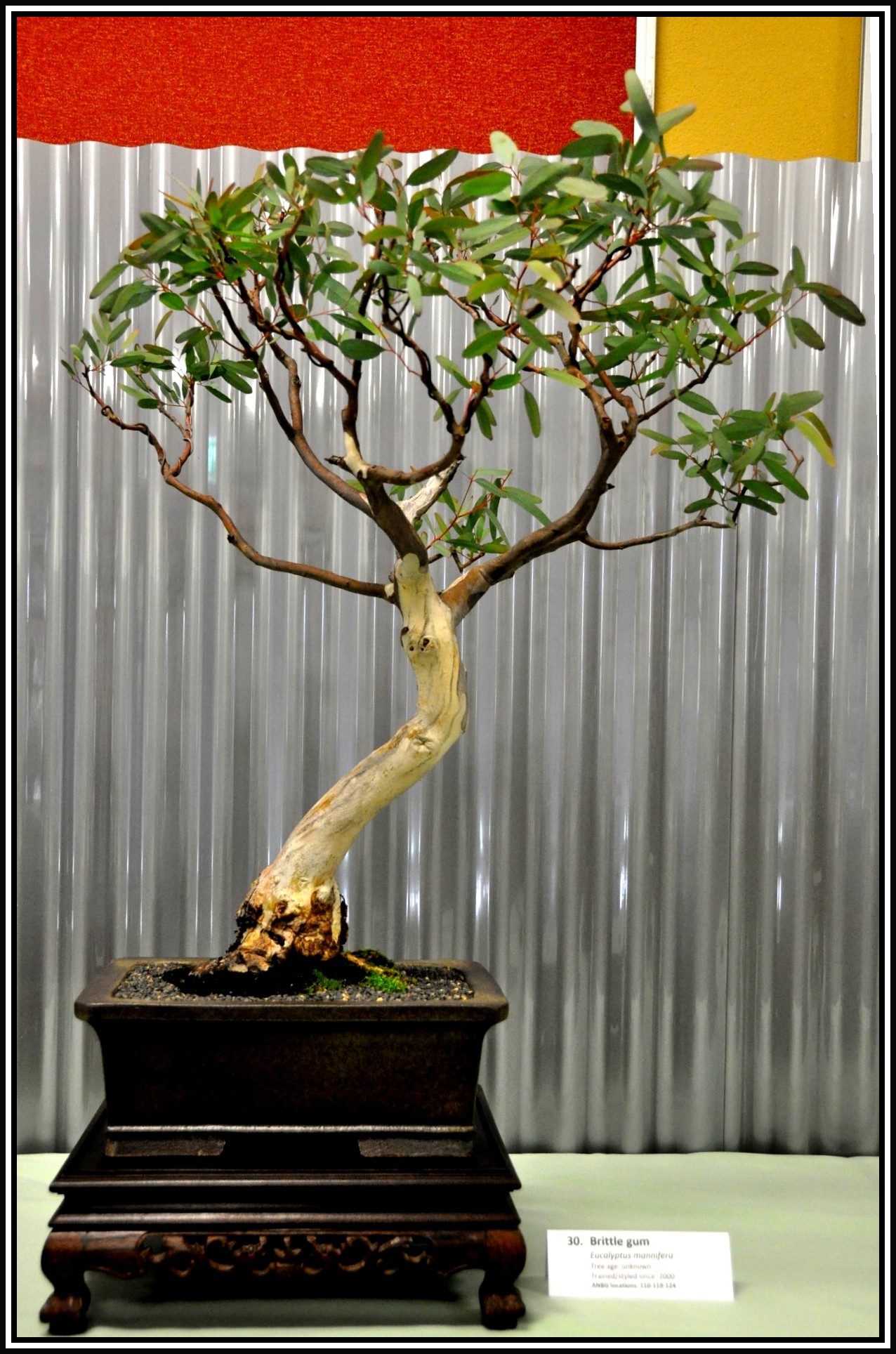 |
31. Sannantha pluriflora
Baeckea
Age of Tree : unknown
Trained/styled since 2003
This tree was bought from a bonsai nursery man who had collected the raw material. I have refined it since buying in 2003.
ANBG locations : 9-11-12-13
|
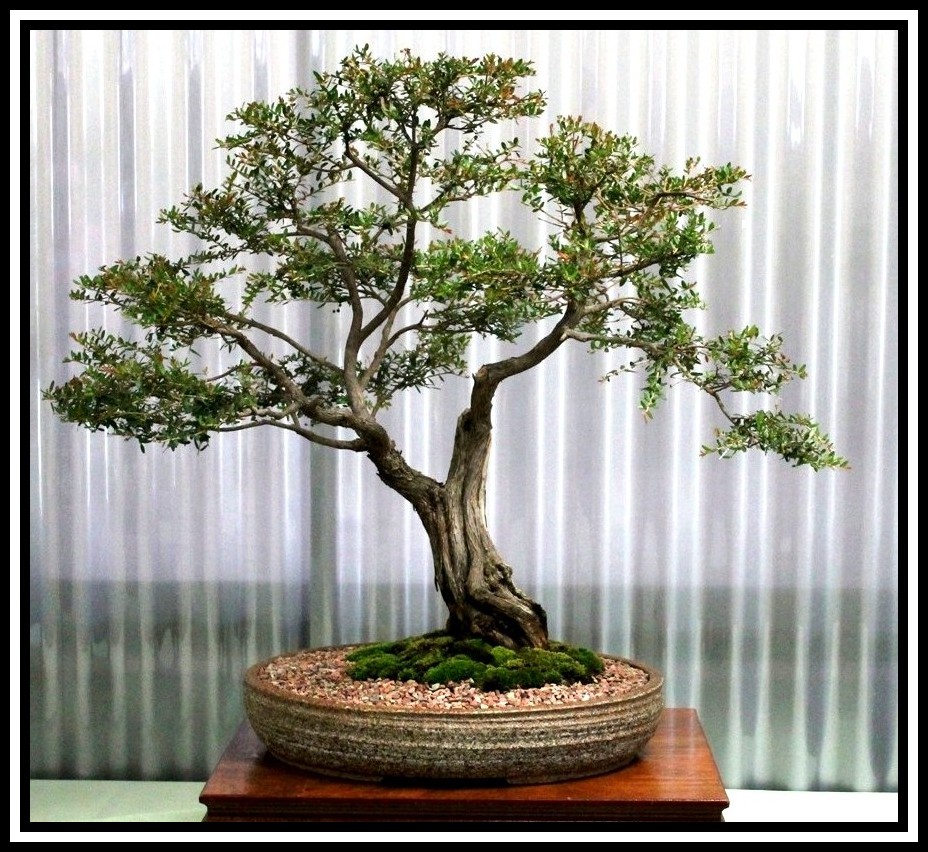 |
32. Ficus rubiginosa
Port Jackson Fig
Age of Tree : 3 years
Trained/styled since 2014
This tree was started as a cutting in September 2012. It was let grow until November 2014 when it was totally defoliated and branches were cut back by 2/3 to achieve better ramification and reduce leaf size. This resulted in the 4 trunks the tree has today.
Figs are extremely frost sensitive so, in Canberra, this tree lives under the eaves in April and inside from May to September. It goes back out under the eaves in September and out into full sun from October to March.
ANBG locations : 64-145-216-219
| |
33. Podocarpus elatus
Plum Pine
Age of Tree : unknown
Trained/styled since 2013
This tree was a gift from a fellow CBS member. It was wired in its initial plastic pot in December 2013. All wire was removed in December 2014 because it was cutting into the tree. The plant was allowed to stay in its original plastic pot to develop a stable root system and was only moved into its first bonsai pot recently.
ANBG locations : 105-148
|
|
34. Syzygium luehmannii
Lilly Pilly "Alamena"
Age of Tree : 3 years
Trained/styled since 2015
This tree was bought in March 2012 at the Australian Plants as Bonsai from a Sydney native grower. The initial styling was undertaken at a workshop with Carol Waller in September 2012. A pinch and grow approach has been used to develop this tree, pinching back new growth regularly. In December 2014 it produced new leaves and the long tips of this new growth were pruned in February 2015.
As it is frost sensitive, in Canberra it lives under the eaves from March to September. For the rest of the year it lives out in full sun.
ANBG locations : 65-147
| |
35. Casuarina cunninghamiana
River She-oak
Age of Tree : 21 years
Trained/styled since 1995
This tree was purchased as a young seedling from Myorea Nursery near Michelago. As it grew, the tree was planted into larger pots, the foliage was pruned to contain the branch growth and some wiring has been done to obtain a reasonable sized bonsai. It was rep;otted from its nursery pot into a mica p;ot in July 2007 and then into a Pat Kennedy pot in July 2008. The tree originally had a tall central trunk. However, a few yhears ago it suffered from some dry-out from lack of water during the summer months. I was keeping the trunk to do some carving. Last year when moving the tree I made the mistake of holding onto the dead part of the trunk and it came off in my hand ! Now I have a tree that shows the diversity that native trees can obtain. When repotting in early December 2014, I discovered that ants had made a home in a hole in the tree, so a sprinkle of ant sand was used to unhouse these unwanted occupants.
ANBG locations : 12-99-124-137
|
 |
36. Eucalyptus stellulata
Black Sallee
Age of Tree : unknown
Trained/styled since 2009
Purchased as a young plant from a Canberra nursery many years ago, this tree was grown for several years in a polystyrene container sitting on my vegetable garden. The roots grew through the bottom of the container which means the tree grew quickly. It was removed, pruned and placed back in the same container.
It dried out last summer and several branches died, but it came back strongly. It is just recovering from a hard prune.
It needs significant training for growth and branch-ramification. It has only been in the current pot for a couple of months.
ANBG locations : 85-175
|
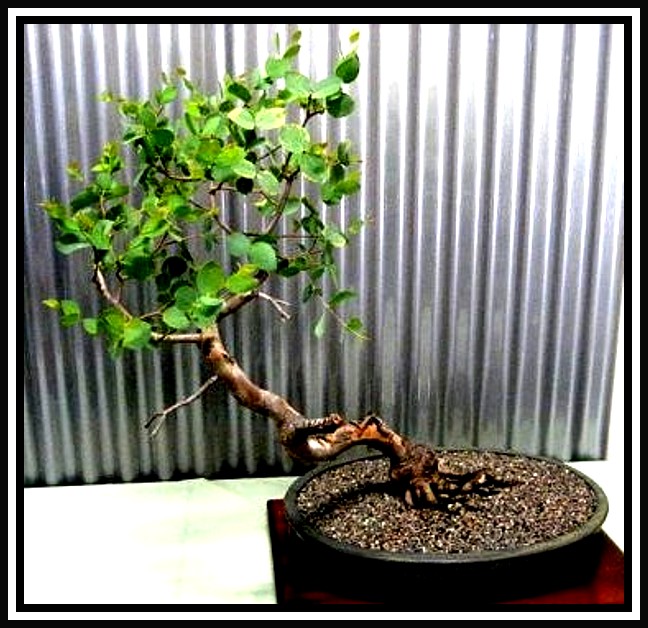 |
37. Burgen
Kunzea ericoides
Age of Tree : 12 years
Trained/styled since 2004
This group planting was inspired by the native trees planted outside the Japanese Gardens in Cowra, NSW.
The group, then consisting of seven trees, was first styled at a demonstration at the Australian Plants as Bonsai Exhibition in 2004. The group is planted in a Pat Kennedy pot. Only two of the original trees survived and in 2006 the group was reconstructed with five new cuttings from the parent tree
The group was re-potted in August 2008. Two trees did not survive as the pot depth was quite low in the front and the repotting mix washes out if not watered correctly. The remaining trees flowered in November/December 2008.
In February 2010, self‐seeded seedlings from the parent plant were combined into the group in several groups of three. The older trees flowered in November 2010.
While repotting in early December 2014, two trees that had died were removed, one from the left side and the trees on the right hand side were wired up to fll the space left by removing the other tree.
ANBG locations: 11-12-124-131
| |






